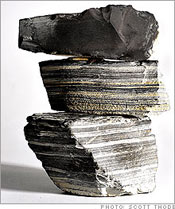Touring a drilling site on a dusty mountain plateau above Rifle, Colo., Harold Vinegar stops, grins and then announces out of the blue, "I love that smell!"
No, the Royal Dutch Shell chief scientist is not referring to the crisp fragrance of the high desert air or the conifer scent wafting from the nearby stand of evergreens. Rather, it's the faint, asphalt-like aroma of oil shale - a sedimentary rock rich in kerogen, a fossil fuel that is now the focus of Shell's single biggest R&D investment.
Vinegar is the energy industry's leading expert on the complex petroscience of transforming solid oil shale into synthetic crude - a liquid fuel that can be refined into diesel and gasoline. The breakthroughs this 58-year-old physicist has achieved could turn out to be the biggest game changer the American oil industry has seen since crude was discovered near Alaska's Prudhoe Bay in 1968.
If that sounds like hyperbole, then consider this: Several hundred feet below where Vinegar is strolling lies the Green River Formation, arguably the largest unconventional oil reserve on the planet. ("Unconventional oil" encompasses oil shale, Canadian tar sands, and the extra-heavy oils of Venezuela - essentially, anything that is not just pumped to the surface.)
Spanning some 17,000 square miles across parts of Colorado, Utah and Wyoming, this underground lakebed holds at least 800 billion barrels of recoverable oil. That's triple the reserves of Saudi Arabia.
The reason you probably haven't heard about the Green River Formation is that most of the methods tried for turning oil shale into oil have been deeply flawed - economically, environmentally or usually both. Because there have been so many false starts, oil shale tends to get lumped with cold fusion, zero-point energy, and other "miracle" fuels perpetually just over the horizon. Read

